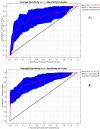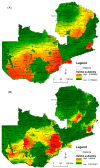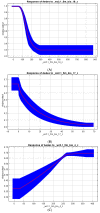Ecological Niche Modeling of Aedes and Culex Mosquitoes: A Risk Map for Chikungunya and West Nile Viruses in Zambia
- PMID: 37766306
- PMCID: PMC10535978
- DOI: 10.3390/v15091900
Ecological Niche Modeling of Aedes and Culex Mosquitoes: A Risk Map for Chikungunya and West Nile Viruses in Zambia
Abstract
The circulation of both West Nile Virus (WNV) and Chikungunya Virus (CHIKV) in humans and animals, coupled with a favorable tropical climate for mosquito proliferation in Zambia, call for the need for a better understanding of the ecological and epidemiological factors that govern their transmission dynamics in this region. This study aimed to examine the contribution of climatic variables to the distribution of Culex and Aedes mosquito species, which are potential vectors of CHIKV, WNV, and other arboviruses of public-health concern. Mosquitoes collected from Lusaka as well as from the Central and Southern provinces of Zambia were sorted by species within the Culex and Aedes genera, both of which have the potential to transmit viruses. The MaxEnt software was utilized to predict areas at risk of WNV and CHIKV based on the occurrence data on mosquitoes and environmental covariates. The model predictions show three distinct spatial hotspots, ranging from the high-probability regions to the medium- and low-probability regions. Regions along Lake Kariba, the Kafue River, and the Luangwa Rivers, as well as along the Mumbwa, Chibombo, Kapiri Mposhi, and Mpika districts were predicted to be suitable habitats for both species. The rainfall and temperature extremes were the most contributing variables in the predictive models.
Keywords: Aedes; Chikungunya virus; Culex; West Nile virus; Zambia; arbovirus; ecological niche modeling.
Conflict of interest statement
The authors declare no conflict of interest. The funders had no role in the design of the study; in the collection, analyses, or interpretation of data; in the writing of the manuscript; or in the decision to publish the results.
Figures






Similar articles
-
Bidirectional Interactions between Arboviruses and the Bacterial and Viral Microbiota in Aedes aegypti and Culex quinquefasciatus.mBio. 2022 Oct 26;13(5):e0102122. doi: 10.1128/mbio.01021-22. Epub 2022 Sep 7. mBio. 2022. PMID: 36069449 Free PMC article.
-
Seroreactivity to Chikungunya and West Nile Viruses in Rwandan Blood Donors.Vector Borne Zoonotic Dis. 2019 Oct;19(10):731-740. doi: 10.1089/vbz.2018.2393. Epub 2019 Jun 27. Vector Borne Zoonotic Dis. 2019. PMID: 31246538
-
Larval Competition between Aedes and Culex Mosquitoes Carries over to Higher Arboviral Infection during Their Adult Stage.Viruses. 2024 Jul 26;16(8):1202. doi: 10.3390/v16081202. Viruses. 2024. PMID: 39205176 Free PMC article.
-
West Nile virus and other mosquito-borne viruses present in Eastern Europe.Pathog Glob Health. 2018 Jul;112(5):233-248. doi: 10.1080/20477724.2018.1483567. Epub 2018 Jul 6. Pathog Glob Health. 2018. PMID: 29979950 Free PMC article. Review.
-
Mosquito-Associated Viruses and Their Related Mosquitoes in West Africa.Viruses. 2021 May 12;13(5):891. doi: 10.3390/v13050891. Viruses. 2021. PMID: 34065928 Free PMC article. Review.
Cited by
-
Predicting the distribution of potentially suitable habitat in China for Cirsium japonicum Fisch. ex DC. under future climate scenarios based on the R-optimized MaxEnt model.Ecol Evol. 2024 Jul 9;14(7):e11653. doi: 10.1002/ece3.11653. eCollection 2024 Jul. Ecol Evol. 2024. PMID: 38983705 Free PMC article.
-
Impact of climatic factors on the occurrence of malaria in hyper, high, moderate and low endemic States in India from 1995 to 2023.Malar J. 2025 Apr 7;24(1):113. doi: 10.1186/s12936-025-05326-5. Malar J. 2025. PMID: 40197352 Free PMC article.
-
Future Climate Predicts Range Shifts and Increased Global Habitat Suitability for 29 Aedes Mosquito Species.Insects. 2025 Apr 30;16(5):476. doi: 10.3390/insects16050476. Insects. 2025. PMID: 40429189 Free PMC article.
-
Impact of climate change on the global circulation of West Nile virus and adaptation responses: a scoping review.Infect Dis Poverty. 2024 May 24;13(1):38. doi: 10.1186/s40249-024-01207-2. Infect Dis Poverty. 2024. PMID: 38790027 Free PMC article.
-
Association of temperature and precipitation with malaria incidence in 57 countries and territories from 2000 to 2019: A worldwide observational study.J Glob Health. 2024 Feb 23;14:04021. doi: 10.7189/jogh.14.04021. J Glob Health. 2024. PMID: 38385445 Free PMC article.
References
-
- Zerbo A., Delgado R.C., González P.A. Aedes-borne viral infections and risk of emergence/resurgence in Sub-Saharan African urban areas. J. Biosaf. Biosecurity. 2020;2:58–63. doi: 10.1016/j.jobb.2020.10.002. - DOI
-
- Proesmans S., Katshongo F., Milambu J., Fungula B., Mavoko H.M., Ahuka-Mundeke S., Da Luz R.I., Van Esbroeck M., Ariën K.K., Cnops L. Dengue and Chikungunya among Febrile Outpatients in Kinshasa, Democratic Republic of Congo: A cross-sectional study. PLoS Negl Trop Dis. 2019;13:e0007047. doi: 10.1371/journal.pntd.0007047. - DOI - PMC - PubMed
Publication types
MeSH terms
LinkOut - more resources
Full Text Sources
Medical
Miscellaneous

